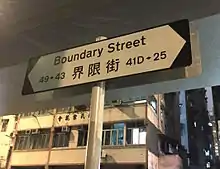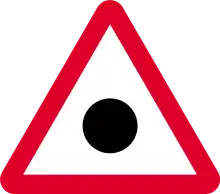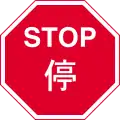Road signs in Hong Kong
Road signs in Hong Kong are standardized by the Transport Department.[1] Due to being a former British territory, the road signage in Hong Kong is similar to road signs in the United Kingdom, with the addition of Chinese characters.

Design and language

Road signs in Hong Kong closely follow those used in the United Kingdom, and complies with the Vienna Convention on Road Signs and Signals, a legacy of the city's previous British overseas territory status. Signs normally use the Transport Medium typeface on dark backgrounds or Transport Heavy on light backgrounds, which is identical to the use in the United Kingdom, Republic of Ireland and most of the current and previous British Overseas Territories
Road signs placed in the 2000s to 2010s commonly use Arial Narrow or Helvetica, with or without a modified letter 'L'; street signs sometimes also use Helvetica. The newest signs built after 2016 have increasingly resumed the use of Transport; some signs on recently completed expressways use Transport Heavy on dark backgrounds.
Writing system on the traffic signs comprises British English and traditional Chinese, two official languages of Hong Kong, in an order of English above Traditional Chinese.
Warnings
Signs warning of hazardous conditions or dangerous situations (e.g. "Intersection" or "Steep incline ahead" bear a black-on-white symbol inside a red-bordered triangle (point uppermost).[2]
 Stop or give way signs ahead (with distance to line ahead given below)
Stop or give way signs ahead (with distance to line ahead given below) Bend to left ahead (right if symbol reversed)
Bend to left ahead (right if symbol reversed) Double bend ahead first to right (symbol may be reversed)
Double bend ahead first to right (symbol may be reversed) Two-way traffic ahead
Two-way traffic ahead Two-way traffic across a one-way road ahead
Two-way traffic across a one-way road ahead Dual carriageway ends ahead
Dual carriageway ends ahead Roundabout ahead
Roundabout ahead Road narrows ahead on right (left if symbol reversed)
Road narrows ahead on right (left if symbol reversed) Road narrows on both sides ahead
Road narrows on both sides ahead Sharp deviation of route (may be used with amber border)
Sharp deviation of route (may be used with amber border).svg.png.webp) Steep hill upwards ahead
Steep hill upwards ahead.svg.png.webp) Steep hill downwards ahead
Steep hill downwards ahead Traffic lights ahead
Traffic lights ahead Traffic Accident blackspot ahead
Traffic Accident blackspot ahead Cross roads ahead
Cross roads ahead Staggered junction ahead (symbol may be reversed)
Staggered junction ahead (symbol may be reversed) Side road ahead (symbol may be reversed)
Side road ahead (symbol may be reversed) T-junc-tion ahead (symbol may be reversed)
T-junc-tion ahead (symbol may be reversed) Traffic merges from left (right if symbol reversed)
Traffic merges from left (right if symbol reversed) Over-head electric cable ahead
Over-head electric cable ahead Quay-side or river bank ahead
Quay-side or river bank ahead Risk of falling or fallen rocks ahead
Risk of falling or fallen rocks ahead Pedestrians on road ahead
Pedestrians on road ahead Pedestrian crossing ahead
Pedestrian crossing ahead Children ahead
Children ahead Low-flying aircraft or sudden aircraft noise ahead
Low-flying aircraft or sudden aircraft noise ahead Horses ahead
Horses ahead Cattle ahead
Cattle ahead Cycles ahead
Cycles ahead Uneven road ahead
Uneven road ahead Road hump ahead
Road hump ahead Advice for cyclists
Advice for cyclists Distance to 'Give way' line
Distance to 'Give way' line Distance to 'Stop' line
Distance to 'Stop' line
Regulatory
With the exception of the special shapes used for "Stop" and "Yield" signs (respectively, an octagon and a downward-pointing triangle), signs giving orders are circular and are of two kinds:[3]
Prohibitory signs (e.g. "No left turn") take the form of a black-on-white symbol inside a red-bordered circle, sometimes with the addition of a red slash through the symbol. Mandatory signs (e.g. "Turn right only") bear a white symbol on a blue disk.
 Give way to traffic on major road
Give way to traffic on major road Stop and give way
Stop and give way Ahead only
Ahead only Keep left (right if symbol reversed)
Keep left (right if symbol reversed) Turn left (right if symbol reversed)
Turn left (right if symbol reversed) Turn left at junction ahead (right if symbol reversed)
Turn left at junction ahead (right if symbol reversed) No stopping
No stopping No waiting (parking)
No waiting (parking) No entry
No entry One way traffic
One way traffic Police checkpoint or roadblock (stop at sign)
Police checkpoint or roadblock (stop at sign) School crossing patrol (stop at sign)
School crossing patrol (stop at sign) Route to be used by pedal cycles only (no motor vehicles)
Route to be used by pedal cycles only (no motor vehicles) Light rail transit (vehicles or trams only)
Light rail transit (vehicles or trams only) All vehicles prohibited, except permitted vehicles
All vehicles prohibited, except permitted vehicles No motor vehicles
No motor vehicles No motor vehicles excluding motorcycles
No motor vehicles excluding motorcycles No motorcycles
No motorcycles No right turn (no left turn if symbol reversed)
No right turn (no left turn if symbol reversed) No U-turn
No U-turn No pedestrians
No pedestrians Pedestrian priority zone
Pedestrian priority zone No cycling
No cycling No use of horn
No use of horn No overtaking
No overtaking No vehicles over width shown
No vehicles over width shown No vehicles over length shown
No vehicles over length shown No vehicles over height shown
No vehicles over height shown No vehicles over gross vehicle weight shown
No vehicles over gross vehicle weight shown No vehicles over gross axle weight shown
No vehicles over gross axle weight shown No learner drivers
No learner drivers Way in for vehicles
Way in for vehicles Way out for vehicles
Way out for vehicles No way out for vehicles
No way out for vehicles No way in for vehicles
No way in for vehicles Except for access if no alternative route
Except for access if no alternative route End of prohibition/restriction
End of prohibition/restriction Distance of prohibition/restriction
Distance of prohibition/restriction Speed limit in kilometres per hour (km/h)
Speed limit in kilometres per hour (km/h).svg.png.webp) Parking for all cars
Parking for all cars.svg.png.webp) Parking for buses and coaches only
Parking for buses and coaches only.svg.png.webp) Motorway begins
Motorway begins.svg.png.webp) Motorway ends
Motorway ends
Temporary/Construction
Temporary road signs (e.g. Red rectangular signs with instructions in white)[4]
 Wait on red light
Wait on red light Road ahead is closed
Road ahead is closed Road closed
Road closed Worded warning sign (wording may be varied)
Worded warning sign (wording may be varied) Temporary route for pedestrians
Temporary route for pedestrians Temporary pedestrian crossing closure
Temporary pedestrian crossing closure Road work ahead
Road work ahead Danger ahead
Danger ahead Slippery road ahead
Slippery road ahead Loose chippings ahead
Loose chippings ahead Manually operated temporary 'Stop' sign
Manually operated temporary 'Stop' sign Manually operated temporary 'Go' sign
Manually operated temporary 'Go' sign
Guide
Guide signs are generally rectangular (sometimes pointed at one end in the case of direction signage).[5]
 Overhead guide sign on major roads.
Overhead guide sign on major roads.
 Interchange sign to Route 6
Interchange sign to Route 6 Roundabout sign with three exits.
Roundabout sign with three exits.
 Motorway route number
Motorway route number Direction sign with destination
Direction sign with destination Direction signs for temporary routes with destination
Direction signs for temporary routes with destination Accident ahead, follow direction of police
Accident ahead, follow direction of police Police roadblock ahead
Police roadblock ahead Direction to MTR station
Direction to MTR station Direction to vehicular ferry pier
Direction to vehicular ferry pier Direction to parking place
Direction to parking place Speed camera ahead
Speed camera ahead Street direction sign
Street direction sign Street direction sign with numbers
Street direction sign with numbers No through road
No through road Advance warning of no through road on left
Advance warning of no through road on left Advance warning of no through road on right
Advance warning of no through road on right.svg.png.webp) Countdown markings to indicate distance from exit (100m)
Countdown markings to indicate distance from exit (100m).svg.png.webp) Countdown markings to indicate distance from exit (200m)
Countdown markings to indicate distance from exit (200m).svg.png.webp) Countdown markings to indicate distance from exit (300m)
Countdown markings to indicate distance from exit (300m) Vehicles may pass either side to reach same destination
Vehicles may pass either side to reach same destination Tunnel ahead
Tunnel ahead To cross harbour tunnel
To cross harbour tunnel
References
- "Chapter 8: The Language of the Road". Transport Department. Retrieved 2020-12-04.
- "Traffic Signs Giving Warning". Transport Department. Retrieved 2020-12-04.
- "Traffic Signs Giving Orders". Transport Department. Retrieved 2020-12-04.
- "Temporary Signs and Road Markings". Transport Department. Retrieved 2020-12-04.
- "Traffic Signs Giving Information". Transport Department. Retrieved 2020-12-04.
| Wikimedia Commons has media related to Road signs in Hong Kong. |